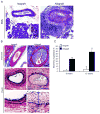A reproducible mouse model of chronic allograft nephropathy with vasculopathy
- PMID: 22874842
- PMCID: PMC3495090
- DOI: 10.1038/ki.2012.277
A reproducible mouse model of chronic allograft nephropathy with vasculopathy
Abstract
Although short-term outcomes in kidney transplantation have improved dramatically, long-term survival remains a major challenge. A key component of long-term, chronic allograft injury in solid organ transplants is arteriosclerosis characterized by vascular neointimal hyperplasia and inflammation. Establishing a model of this disorder would provide a unique tool not only to identify mechanisms of disease but also to test potential therapeutics for late graft injury. To this end, we utilized a mouse orthotopic renal transplant model in which C57BL/6J (H-2b) recipients were given either a kidney allograft from a completely mismatched Balb/cJ mouse (H-2d) or an isograft from a littermate. A unilateral nephrectomy was performed at the time of transplant followed by a contralateral nephrectomy on post-transplant day 7. Recipients were treated with daily cyclosporine subcutaneously for 14 days and then studied 8 and 12 weeks post transplantation. Renal function was significantly worse in allograft compared with isograft recipients. Moreover, the allografts had significantly more advanced tubulointerstitial fibrosis and profound vascular disease characterized by perivascular leukocytic infiltration and neointimal hyperplasia affecting the intrarenal blood vessels. Thus, we describe a feasible and reproducible murine model of intrarenal transplant arteriosclerosis that is useful to study allograft vasculopathy.
Figures




Similar articles
-
A Small Molecule β2 Integrin Agonist Improves Chronic Kidney Allograft Survival by Reducing Leukocyte Recruitment and Accompanying Vasculopathy.Front Med (Lausanne). 2014 Nov 12;1:45. doi: 10.3389/fmed.2014.00045. eCollection 2014. Front Med (Lausanne). 2014. PMID: 25593918 Free PMC article.
-
Impact of Leukocyte Function-Associated Antigen-1 Blockade on Endogenous Allospecific T Cells to Multiple Minor Histocompatibility Antigen Mismatched Cardiac Allograft.Transplantation. 2015 Dec;99(12):2485-93. doi: 10.1097/TP.0000000000000805. Transplantation. 2015. PMID: 26102611
-
Immunobiology and long-term graft function in a transplant heterotopic renal rat model.Clin Transplant. 2002;16 Suppl 7:6-14. doi: 10.1034/j.1399-0012.16.s7.1.x. Clin Transplant. 2002. PMID: 12372038
-
Treatment strategies to minimize or prevent chronic allograft dysfunction in pediatric renal transplant recipients: an overview.Paediatr Drugs. 2009;11(6):381-96. doi: 10.2165/11316100-000000000-00000. Paediatr Drugs. 2009. PMID: 19877724 Review.
-
Quantitation of allograft fibrosis and chronic allograft nephropathy.Pediatr Transplant. 1999 Nov;3(4):257-70. doi: 10.1034/j.1399-3046.1999.00044.x. Pediatr Transplant. 1999. PMID: 10562970 Review.
Cited by
-
Transcript Engineered Extracellular Vesicles Alleviate Alloreactive Dynamics in Renal Transplantation.Adv Sci (Weinh). 2022 Nov;9(31):e2202633. doi: 10.1002/advs.202202633. Epub 2022 Sep 8. Adv Sci (Weinh). 2022. PMID: 36073846 Free PMC article.
-
Orthotopic kidney transplantation in mice: technique using cuff for renal vein anastomosis.PLoS One. 2013 Oct 14;8(10):e77278. doi: 10.1371/journal.pone.0077278. eCollection 2013. PLoS One. 2013. PMID: 24155935 Free PMC article.
-
M2 Macrophages Serve as Critical Executor of Innate Immunity in Chronic Allograft Rejection.Front Immunol. 2021 Mar 17;12:648539. doi: 10.3389/fimmu.2021.648539. eCollection 2021. Front Immunol. 2021. PMID: 33815407 Free PMC article. Review.
-
Lymphatic Reconstruction in Kidney Allograft Aggravates Chronic Rejection by Promoting Alloantigen Presentation.Front Immunol. 2021 Dec 9;12:796260. doi: 10.3389/fimmu.2021.796260. eCollection 2021. Front Immunol. 2021. PMID: 34956231 Free PMC article.
-
Anti-donor MHC Class II Alloantibody Induces Glomerular Injury in Mouse Renal Allografts Subjected to Prolonged Cold Ischemia.J Am Soc Nephrol. 2019 Dec;30(12):2413-2425. doi: 10.1681/ASN.2018111169. Epub 2019 Oct 9. J Am Soc Nephrol. 2019. PMID: 31597715 Free PMC article.
References
-
- Nankivell BJ, Kuypers DR. Diagnosis and prevention of chronic kidney allograft loss. Lancet. 2011;378:1428–1437. - PubMed
-
- Li C, Yang CW. The pathogenesis and treatment of chronic allograft nephropathy. Nat Rev Nephrol. 2009;5:513–519. - PubMed
-
- Djamali A, Premasathian N, Pirsch JD. Outcomes in kidney transplantation. Semin Nephrol. 2003;23:306–316. - PubMed
-
- Rahmani M, Cruz RP, Granville DJ, et al. Allograft vasculopathy versus atherosclerosis. Circ Res. 2006;99:801–815. - PubMed
Publication types
MeSH terms
Substances
Grants and funding
LinkOut - more resources
Full Text Sources
Other Literature Sources
Medical

